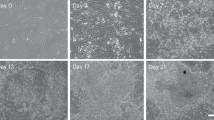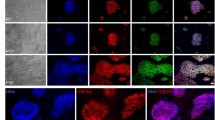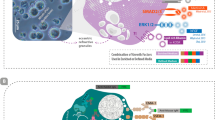Abstract
Since the landmark study of Wilmut et al. (Wilmut et al. in Nature 385:810, 1997) describing the birth of a cloned lamb derived from a somatic cell nucleus, there has been debate about the donor nucleus cell cycle stage required for somatic cell nuclear transfer (NT). Wilmut et al. (Wilmut et al. in Nature 385:810, 1997) suggested that induction of quiescence by serum starvation was critical in allowing donor somatic cells to support development of cloned embryos. In a subsequent report, Cibelli et al. (Cibelli in Science 280:1256, 1998) proposed that G0 was unnecessary and that calves could be produced from actively dividing fibroblasts. Neither study conclusively documented the importance of donor cell cycle stage for development to term. Other laboratories have had success with NT in several species (Wilmut et al. in Nature 385:810, 1997, Cibelli in Science 280:1256, 1998, Baguisi in Nat. Biotechnol. 17:456, 1999, Kubota in Proc. Natl. Acad. Sci. USA 973:990, 2000, Wakayama et al. in Nature 23:369, 1998, Wells et al. in Biol. Reprod. 60:996, 1999, Polejaeva in Nature 407:505, 2000) and most have used a serum starvation treatment. Here we evaluate methods for producing G0 and G1 cell populations and compare development following NT. High confluence was more effective than serum starvation for arresting cells in G0. Pure G1 cell populations could be obtained using a “shake-off” procedure. No differences in in vitro development were observed between cells derived from the high-confluence treatment and from the “shake-off” treatment. However, when embryos from each treatment were transferred to 50 recipients, five calves were obtained from embryos derived from “shake-off” cells, whereas no embryos from confluent cells survived beyond 180 days of gestation. These results indicate that donor cell cycle stage is important for NT, particularly during late fetal development and that actively dividing G1 cells support higher development rates than cells in G0.
This is a preview of subscription content, access via your institution
Access options
Subscribe to this journal
Receive 12 print issues and online access
$209.00 per year
only $17.42 per issue
Buy this article
- Purchase on Springer Link
- Instant access to full article PDF
Prices may be subject to local taxes which are calculated during checkout


Similar content being viewed by others
References
Wilmut, I., Schnieke, A.E., McWhir, J., Kind, A.J. & Campbell, K.H. Viable offspring derived from fetal and adult mammalian cells. Nature 385, 810–813 (1997).
Cibelli, J.B. et al. Cloned transgenic calves produced from nonquiescent fetal fibroblasts. Science 280, 1256–1258 (1998).
Baguisi, A. et al. Production of goats by somatic cell nuclear transfer. Nat. Biotechnol. 17, 456–461 (1999).
Kubota, C. et al. Six cloned calves produced from adult fibroblast cells after long term culture. Proc. Natl. Acad. Sci. USA 973, 990–995 (2000).
Wakayama, T., Perry, A.C., Zuccotti, M., Johnson, K.R. & Yanagimachi, R. Full term development of mice from enucleated oocytes injected with cumulus cell nuclei. Nature 23, 369–374 (1998).
Wells, D.N., Misica, P.M. & Tervit, H.R. Production of cloned calves following nuclear transfer with cultured adult mural granulosa cells. Biol. Reprod. 60, 996–1005 (1999).
Polejaeva, I.A. et al. Cloned pigs produced by nuclear transfer from adult somatic cells. Nature 407, 505–509 (2000).
Gadbois, D.M., Crissman, H.A., Tobey, R.J. & Bradbury, E.M. Multiple kinase arrest points in the G1 phase of non-transformed mammalian cells are absent in transformed cells. Proc. Natl. Acad. Sci. USA 89, 8626–8630 (1992).
Freshney, I.R. (ed.) Culture of animal cells, Edn. 3. (Wiley-Liss Inc., New York; 1994).
Kasinathan, P. et al. Effect of fibroblast donor cell age and cell cycle on development of bovine nuclear transfer embryos in vitro. Biol. Reprod. 64, 1487–1493 (2001).
Liu, L., Ju. J. & Yang, X. Parthenogenetic development and protein patterns of newly matured bovine oocytes after chemical activation. Mol. Reprod. Dev. 49, 298–307 (1998).
Presicce, G.A. & Yang, X. Parthenogenetic development of bovine oocytes matured in vitro for 24 hr and activated by ethanol and cycloheximide. Mol. Reprod. Dev. 38, 380–385 (1994).
Acknowledgements
The authors gratefully acknowledge Tara L. King, Karli J. Wright and Warren S. Lucero for their technical assistance and Audy R. Spell for embryo transfer. This work was supported in part by US Department of Agriculture grants no. 1997-03976 and 1999-03319 to D.J.J. and J.M.R.
Author information
Authors and Affiliations
Rights and permissions
About this article
Cite this article
Kasinathan, P., Knott, J., Wang, Z. et al. Production of calves from G1 fibroblasts. Nat Biotechnol 19, 1176–1178 (2001). https://doi.org/10.1038/nbt1201-1176
Received:
Accepted:
Published:
Issue Date:
DOI: https://doi.org/10.1038/nbt1201-1176
This article is cited by
-
Acceleration of genetic gain in cattle by reduction of generation interval
Scientific Reports (2015)
-
Therapeutic potential of somatic cell nuclear transfer for degenerative disease caused by mitochondrial DNA mutations
Scientific Reports (2014)
-
Generation of SV40-transformed rabbit tracheal-epithelial-cell-derived blastocyst by somatic cell nuclear transfer
Cell and Tissue Research (2012)
-
Animal transgenesis: state of the art and applications
Journal of Applied Genetics (2007)
-
Aberrant profile of gene expression in cloned mouse embryos derived from donor cumulus nuclei
Cell and Tissue Research (2006)



